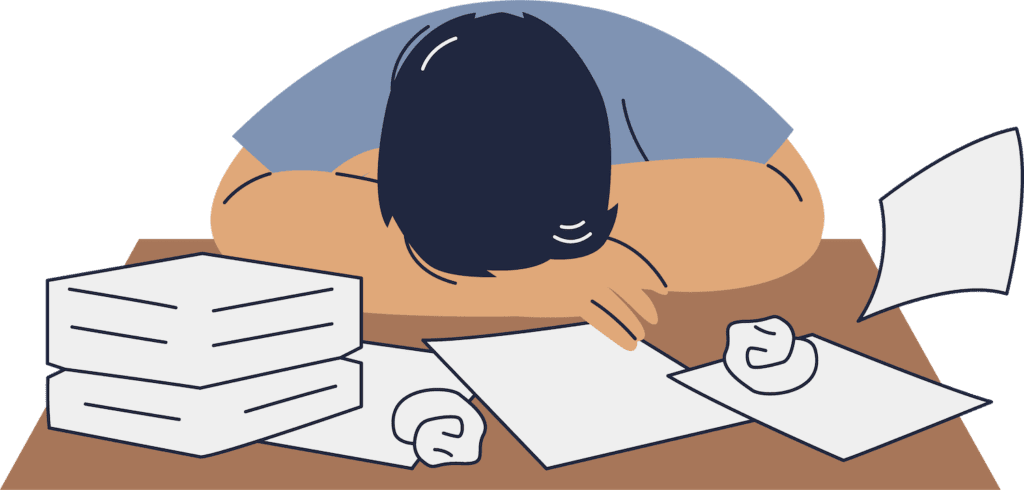Why we really put things off
Procrastination is often painted as the enemy of productivity, blamed for missed deadlines, unnecessary stress, and endless frustration. But what if procrastination is more than just a bad habit? Instead of focusing on the surface—poor time management, distraction, or laziness—let’s dive deeper. Procrastination is often driven by complex psychological forces that we rarely talk about. In fact, four key drivers could be influencing why you keep delaying that task. Understanding these might just change how you approach your work—and yourself. Let’s explore the real reasons behind why we put things off.
Some Procrastination Myths
It is the act of stalling, halting, or postponing finishing a task. But, it is not the same as being idle or inefficient. When we are lazy, we are disinclined to finish a task. We prefer to remain inactive or do something else. Whereas procrastination is about delaying task completion.
So, unlike someone who is lethargic, a procrastinator aspires and intends to complete the task in question.
Laziness is more commonly used to characterise conduct that does not meet someone’s expectations. Judging conduct as lazy is a matter of subjective opinion and does not have a specific cause. It is not a formal term. Even one person’s idea of lazy maybe another’s idea of a busy day!
So is it a problem of insufficient time management rather than laziness?
Making the most of our time can maximise productivity and make sure we arrange our priorities properly. It is about structuring, designing and setting tasks to meet deadlines. This may include divvying up tasks to others and aiding them in executing said tasks.
It involves defining targets, arranging our workspace and formulating how to break our time into constructive portions, which reduce stress and amplify our results.
Excellent planning is found in any time management strategy. It’s about managing time to deliver against demands. Time management is part of our organisational skills. The reasons for poor output as a result of procrastinating and frittering away time by delaying a task is not improved by new or extra time management processes or tools.
What happens when we procrastinate ?
Reflections of finishing a task can provoke uneasiness and we can soothe the signs of uneasiness by putting off the task. It is a logical and effective emotional coping mechanism for dealing with unpleasant feelings.
This allows us to repair that distress to feel better.
The nature of procrastination is essentially “a self-defeating behaviour pattern marked by short-term benefits and long-term costs” (1)
Although this strong feeling of anxiety recedes, if we say I’ll do it later. It is a short-term coping mechanism. But it does not resolve any issues around completing the task.

What sits behind I’ll do it later?
Motivation Breakdown
Some research (2) tells us we obtain inspiration from two sources – internal and external motivation.
Extrinsic motivation relates to external driving forces, which can be positive or negative like acquiring awards, getting money or gifts, vacation, or a fear of being seen as a failure or receiving penalty for not finishing a task.
Intrinsic motivation is based on internal stimulus like autonomy, becoming a specialist in a subject, fondness of the topic, taking pride in achievements.
Another theory focuses on needs. (3) McClelland’s Need Theory references three needs: achievement, power, and affiliation. They are:
- Need for Achievement: Drive to reach and realise success relative to a set of standards. Compete to win, ambitious high-need achiever, assume personal responsibility for executing a task, for uncovering a solution, accomplishing complicated objectives, taking calculated risks.
- Need for Power: Desire to persuade others and influence people, enjoy having sway over people and events. This results in ultimate satisfaction. It includes wanting to shape and exercise control over others. Being the leader is key.
- Need for affiliation: Yearning to create and keep up amicable and cozy relations. With a powerful drive for recognition and endorsement from others, adjust to the wants of those individuals whose emotions they respect and companionship and fellowship they cherish.
- Being motivated is our path to taking action for success, which means we fulfil what we promised ourselves. And yet many times our motivation can breakdown. This can lead to delay and putting off a task. Our motivation is influenced by our self-concept and our beliefs.Do it Don’t Quit isn’t always easy despite incentives and resources.
Shaky Self-Concept and Negative Beliefs
Roger’s approach (4) suggests forming a healthy sense of self is an ongoing mission shaped by our life experiences. Those with a sound sense of self have more confidence and manage more productively with life’s obstacles. Parenting influences self-concept development during childhood. Caregivers who offer their children unconditional affection and respect are more likely to nurture a healthy self-concept. Children who feel they have to ‘deserve’ their parents’ love may end up with low self-esteem and feelings of unworthiness.
During childhood is where our core beliefs get established. These fundamental beliefs are our most profoundly held speculations about ourselves, the world, and others.A belief is something we consider being true based on fact or an opinion or speculation. It is a belief and thought about something, which can be distorted and wrong.
Early in life, we form central convictions moulded by our upbringing and life lessons. Because they are so deep-seated and embedded, they are very difficult to change. Their original goal is to help us make sense of our formative events, but they can become counterproductive or even damaging later in life. (5) .
But as we set them out from a young age, we look for evidence that strengthens them, and ignore anything that might challenge them. They influence our sense of self by boosting or decreasing our self-esteem.

Our self-concept comprises:
- Self-image – how we see ourselves in the moment
- Ideal self – the person we want to be
- Self-esteem – how much we like, accept and value ourselves (4)
If our core beliefs are negative, then it can mean:
- Helplessness – personal incompetence, vulnerability, and inferiority.
- Unlovability – fear that we are not-likeable and incapable of intimacy,
- Worthlessness – we are insignificant and a burden to others (6)
We have a concept of our ideal self. The problem is our image of who we think we should be does not always match up with our perceptions of who we are today. When our self-perception does not line up with our ideal self, we are in a state of disharmony.(4)
If our self-image and ideal self are not in harmony, then this can lead to anxiousness. When we are uneasy, we can determine to counterbalance and abate that feeling by distorting our experience and ignoring a threat. (4)
It is a lack of self-worth which is produced from the discrepancy between our self image and ideal self. Our core beliefs affect our self-esteem. So we can feel incompetent, vulnerable or unlovable or insignificant.It erodes our self-esteem. If we have low self-esteem and negative core values it affects our ability to complete tasks.
In a flash
Sometimes our thoughts materialise so quickly we overlook them. These thoughts shape how we feel. If these are constructive notions, then it is not so much of an issue. But when detrimental can affect our emotions and behaviours dramatically. This can occur without us noticing it.
A model outlined three interrelated levels of cognition explain this further:
- Core beliefs
- Dysfunctional assumptions
- Negative automatic thoughts
We can think of our counterproductive automatic thoughts as results of our unworkable assumptions and core beliefs. (7)
If we comprehend how our motivations, self-concept, primary beliefs form our view of ourselves. Then we can develop solutions to alleviate procrastination getting in the way of completing tasks.

Reactionary Nervous System
Lastly, let’s consider: what is happening in our bodies when we are procrastinating? Our bodies can determine the notion of not finishing the task as a threat.
The Limbic System is unique and a dominant portion of our brains. It’s processes are mostly automatic.This area of the brain functions like a command centre communicating with the rest of the body through our nervous system. It tells us when we feel like we have to eg, flee from an unpleasant situation.
We have the choice of: Flight, Flight, Freeze, or Fawn to respond to threats. (8). These are trauma responses. Frequent, intense fear responses when there is not an actual threat can be a sign of anxiety. Irrespective of which one we select, it means not completing the task.
Procrastination is not solely a mindset process. While our minds affect our emotions, choices and behaviours, it is a physiological process too. It is what happens when our brains perceives a real or imagined threat, including stress or trauma.
Let us recognise motivation breakdown, shaky self-concept/negative beliefs and physical response behind any procrastinating behaviour. It’s the first step to diminishing procrastination. Let’s check out what deferral of a task means this week. Together with the factors involved before critiquing ourselves and others.
References:
1. Tice, Dianne .M. and Baumeister, Roy F (1997) Longitudinal study of procrastination, performance, stress, and health: The costs and benefits of dawdling Psychological Science, 8 (6) (1997), pp. 454-458
2. Deci, Edward, L. & Ryan, Richard, M. (1985).Intrinsic motivation and self-determination in human behavior. New York: Plenum Press.
Deci, Edward, L. & Ryan, Richard, M. (2000). The ‘what’ and ‘why’ of goal pursuits: Human needs and the self-determination of behavior.Psychological Inquiry, 11, 227-268
Deci, Edward, L. & Ryan, Richard, M. (2000). Self-determination theory and the facilitation of intrinsic motivation, social development, and well-being. American Psychologist, 55, 68-78.
3. McClelland, David. (1961) The Achieving Society. New York: Van Nostrand
McClelland, David and Burnham, David (1977), Power is the Great Motivator, Harvard Business Review,
McClelland, David. (1988). Human Motivation, Cambridge University Press.
4. Rogers, Carl. (1951) Client-Centered Therapy: Its Current Practice, Implications, and Theory. Boston: Houghton Mifflin.
Rogers, Carl. (1961) On Becoming a Person: A Therapist’s View of Psychotherapy. Boston: Houghton Mifflin.
Rogers, Carl. (1980) A Way of Being. Boston: Houghton Mifflin.
5. Osmo, F., Duran, V., Wenzel, A., de Oliveira, I. R., Nepomuceno, S., Madeira, M., & Menezes, I. (2018). The negative core beliefs inventory: Development and psychometric properties. Journal of Cognitive Psychotherapy, 32(1), 67–84.
6. Beck, Judith S. (2005). Cognitive therapy for challenging problems: What to do when the basics don’t work. Guilford Press.
Beck, Judith S. (2011). Cognitive behavior therapy: Basics and beyond (2nd ed.). Guilford Press.
7. Beck, Aaron. T. (1979). Cognitive therapy and the emotional disorders. Meridian.
8. Cannon, Walter B (1915). Bodily changes in pain, hunger, fear, and rage. New York: Appleton-Century-Crofts.
Cannon, Walter B (1932). Wisdom of the Body. United States: W.W. Norton & Company.
Walker, Peter (2013). Complex PTSD: From Surviving to Thriving : a Guide and Map for Recovering from Childhood Trauma.
This article protected by EU & International Copyright Laws.
© 2023 Lifexpression Limited All Rights Reserved. © 2023 Moira Devlin © 2023 Shutterstock.com. © 2023 Envato Pty Limited


